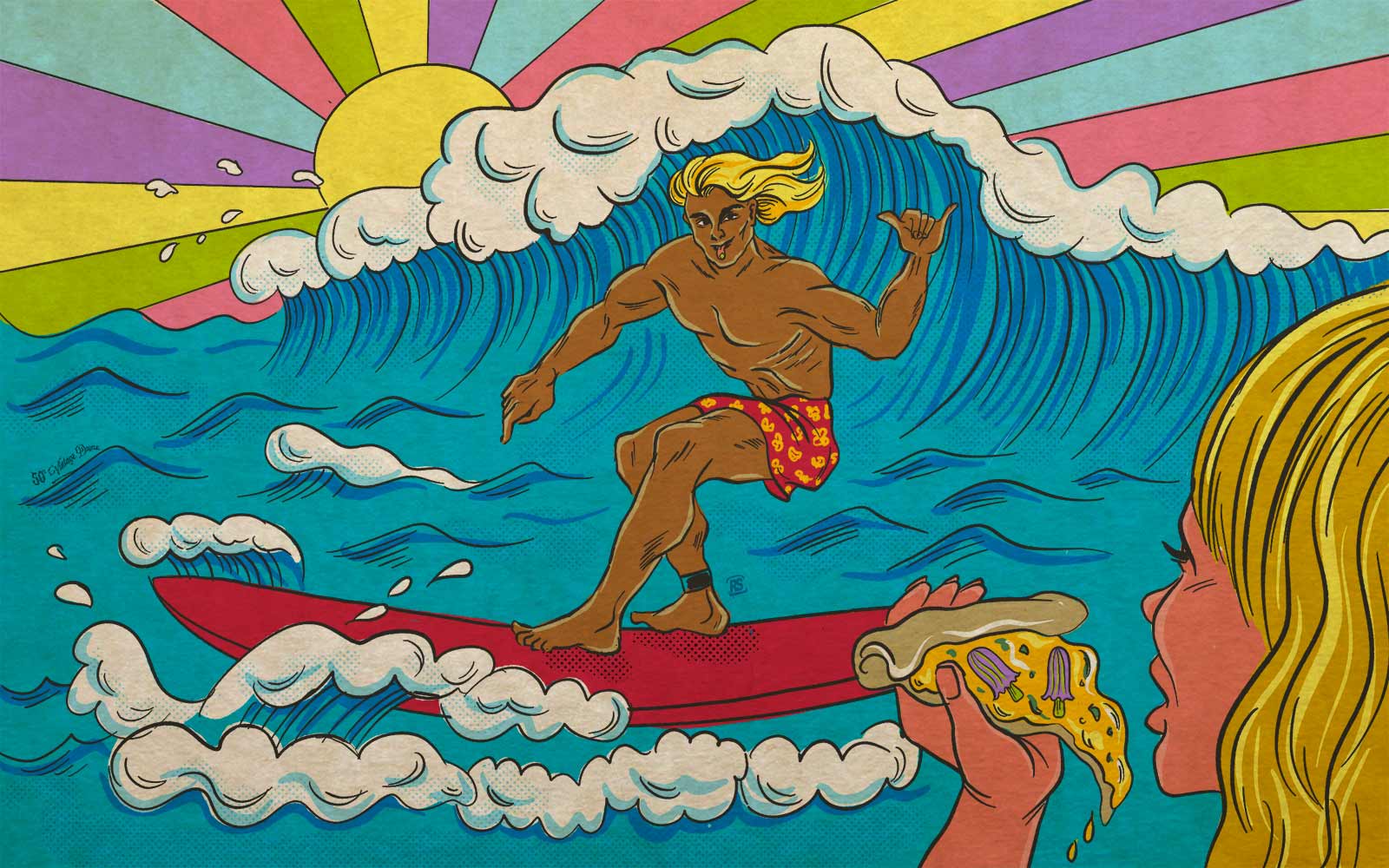If asked to conjure up a mental image of a surfer there are plenty of stereotypes to draw on like long hair, maybe lives in a van and smokes weed. Like most stereotypes, this view is myopic and surfing has evolved from a fringe counterculture activity to a sport worthy of a place in the Olympics. The lore surrounding catching waves and enjoying psychoactive substances is not unfounded as the roots of surf culture lie in the narrative of hopping fences and giving the finger to the establishment. As more research points towards the potential medicinal benefits, the stigma surrounding plant medicines lightens enough for all people — including surfers — to explore the benefits of psychedelics. So, are there advantages in combining psychedelics and surfing, specifically? Let’s get into it below.
History of Surfing
Surfing originated in the tropical oceans of Polynesia hundreds of years before it appeared in the colonial writings of William Anderson in 1777. What started as riding waves on canoes got honed over generations until the northernmost Polynesian islands — the Hawaiian islands — crafted finless wooden slabs reminiscent of today’s surfboards. The earliest Hawaiian surfers were after more than the thrill of getting barrelled as surfing held spiritual significance. Ceremonial rules governed every aspect of surfing, from deciding what tree to make boards from and praying to the gods for waves and protection.
Another fixture of Polynesian religious practices was the consumption of kava root. Thought to be brought over from the ancestral homelands by the gods, kava was a sacred part of Hawaiian religious ceremonies. At first, only community members of high social standing were permitted to consume it but kava root tea quickly became a commonplace beverage for all members of Hawaiian society. Apart from helping connect the drinker to the divine, the tea enhanced mental clarity, relaxation and focus.
Upon their arrival to the islands in 1820, white missionaries demonized Hawaiian spiritual practices, including surfing. Bringing with them disease and chaos, colonists decimated the Hawaiian population over the following decades, overthrowing Queen Lili’uokalani in 1893 and leading to the United States annexation of Hawaii in 1898.
The loss of independence was a horrific blow to the Hawaiian people, commencing a native-led revival of surfing in the following years. This revival was unfortunately co-opted by colonizers like Alexander Hume Ford. A former South Carolinian, Ford saw this surfing revival as a way to draw tourists and potential settlers to the islands. He promoted the activity to white American and Australian audiences and made a lasting impact on the surf world.
The surge in surfing inspired Hawaiian-born George Freeth to take up the sport and bring surfing demonstrations to the beaches of Southern California. Not long after, swimmer Duke Kahanamoku wowed the people of Australia and New Zealand with his surfing whilst competing in the 1914 Olympics. Leaving behind its roots in Hawaiian and Polynesian culture, surfing was now a growing industry in California and Australia.
Surfing in the 1960s
In 1961, the United States Surfing Association was founded as the first professional surfing organization. Surfing at the time was flush with psychedelics. The Brotherhood of Eternal Love — a group of surfers producing and distributing the iconic Orange Sunshine acid — dosed the entire Southern California area and helped establish the connection between surfing and psychedelics. At the time, surfing was associated with the hippie movements occurring throughout California and therefore the reputations of debauchery associated with the long-haired dropouts.
Timothy Leary spoke of the connections between acid trips and the meditative experience of surfing. A surfer himself, he believed the merging of brain, body and nature in the ocean was the perfect vehicle to tune into the interconnectedness of the universe. By tapping into the rhythms of the ocean and flowing along with energy that has traveled thousands of miles, surfers are able to connect with the natural world and achieve an altered consciousness not unlike a psychedelic trip.
Surfing in the 1970s
The 1970s brought about a shift in surf culture. Where most shapers relied on the tried and true longboards of earlier decades, the 1970s brought about the desire for shorter, high-performance surfboards. The high-performance shapes allowed short boarders to cut back across the face of the wave, whipping their boards from horizontal to vertical in ways unattainable on a ten-foot longboard.
The ‘70s marked the beginnings of the War on Drugs and the public opinion of psychedelic use shifted towards fear and penalization. For surfers, this did not help their reputation amongst more conservative communities. The stigmatization of surfers as lazy non-contributors influenced the rise of localism during this time. Especially in lower-income areas, surfers pushed back against outsiders and leaned into the rebellion and freedom that came along with the popular conceptions of surfing. No longer the free-loving hippies of the ‘60s, surfers worked to legitimize their craft as a sport. In 1976 the World Surf League was formed.
The 1970s music culture of “sex, drugs and rock and roll” also affected the surfing world. Substance use grew as more young professional surfers joined the competition circuit. The stress that comes along with money, fame and notoriety can be a risk factor for substance abuse and the surfing community did not escape the tragedies of death and loss.
Modern Surfing and Psychedelics
Over the following decades, the surfing industry grew into the 20 billion dollar industry it is today. Surfing’s reputation as a worthy and healthful pastime took time to free itself from the misconceptions and truths of its history. Prominent voices in the surfing community push back against the idea that surfing equates to substance use. Respected members of the surf community like Dan Malloy, Rob Machado and Bethany Hamilton speak of the dangers of drug use. However, as the conversation around plant medicine shifts, so do the attitudes surrounding psychedelics.
Kelly Slater, arguably the greatest surfer of all time, spoke out against drug use of any kind during his rise to fame in the ‘80s and ‘90s. Notably telling reporters about wanting to beat someone up who offered him a tab of acid when he was a teenager. Today he sings a different tune, testifying that plant medicines, specifically, ayahuasca have changed his life and allowed him to heal past emotional wounds.
New research points to the connections between LSD and high-adrenaline action sports. The rebellious connotation of extreme outdoor sports allows for more leniency surrounding other “risky” behavior. This could explain the connection between psychedelic use in board sports, mountain biking and climbing. While on LSD, researchers have found evidence for increased reaction time, improved balance and strengthened endurance — all helpful tools for an action sport.
Do Psychedelics and Surfing Go Together?
Both psychedelics and surfing mean different things to different people. Surfing is an individual sport. Though community exists, it is up to each surfer to define their relationship with an activity much more nuanced than sitting on a board in the ocean. What type of board do they prefer? What type of waves? What type of feeling are they searching for?
Psychedelic experiences are also individual explorations of shifted perception and consciousness. People react differently and get various things out of their psychedelic experiences. For better or worse, surfing and psychedelics seem to remain intertwined as the cultural dialogue continues to change. Even traditional practices find their way into the modern surf world. During the opening ceremonies of the Volcom Fiji Pro in 2012, all competitors took part in traditional kava practices alongside their Polynesian hosts. Recognizing and respecting history promotes progress. As for psychedelics, they haven’t seen their last days in the water.
Psychonaut Thoughts
Do you think psychedelics and surfing go together? We would love to know what you think about this aquatic pastime in the comments below. If you want more content exploring the reaches of psychedelia, subscribe to our newsletter below.













